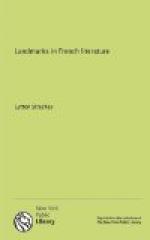Jodelle. Corneille’s achievement was based
upon a combination of what was best in these two movements.
The work of Jodelle, written with a genuinely artistic
intention, was nevertheless a dead thing on the stage;
while Hardy’s melodramas, bursting as they were
with vitality, were too barbaric to rank as serious
works of art. Corneille combined art with vitality,
and for the first time produced a play which was at
once a splended piece of literature and an immense
popular success. Henceforward it was certain
that French drama would develop along the path which
had been opened out for it so triumphantly by the
Cid. But what was that path? Nothing
shows more strikingly the strength of the literary
opinion of that age than the fact that it was able
to impose itself even upon the mighty and towering
spirit of Corneille. By nature, there can be little
doubt that Corneille was a romantic. His fiery
energy, his swelling rhetoric, his love of the extraordinary
and the sublime, bring him into closer kinship with
Marlowe than with any other writer of his own nation
until the time of Victor Hugo. But Corneille
could not do what Marlowe did. He could not infuse
into the free form of popular drama the passion and
splendour of his own genius, and thus create a type
of tragedy that was at once exuberant and beautiful.
And he could not do this because the literary theories
of the whole of the cultivated society of France would
have been opposed to him, because he himself was so
impregnated with those very theories that he failed
to realize where the true bent of his genius lay.
Thus it was that the type of drama which he impressed
upon French literature was not the romantic type of
the English Elizabethans, but the classical type of
Senecan tragedy which Jodelle had imitated, and which
was alone tolerable to the French critics of the seventeenth
century. Instead of making the vital drama of
Hardy artistic, he made the literary drama of Jodelle
alive. Probably it was fortunate that he did
so; for he thus led the way straight to the most characteristic
product of the French genius—the tragedy
of Racine. With Racine, the classical type of
drama, which so ill befitted the romantic spirit of
Corneille, found its perfect exponent; and it will
be well therefore to postpone a more detailed examination
of the nature of that type until we come to consider
Racine himself, the value of whose work is inextricably
interwoven with its form. The dominating qualities
of Corneille may be more easily appreciated.
He was above all things a rhetorician; he was an instinctive master of those qualities in words which go to produce effects of passionate vehemence, vigorous precision, and culminating force. His great tirades carry forward the reader, or the listener (for indeed the verse of Corneille loses half its value when it is unheard), on a full-flowing tide of language where the waves of the verse, following one another in a swift succession of ever-rising power, crash down at




